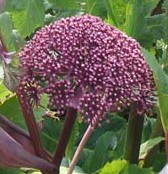
This tall biennial or perennial is a native of Asia where it inhabits forests and grasslands. It is a member of the carrot family, Umbelliferae, that also includes celery, sea holly and Queen Anne’s lace. The plant grows 3-6′ tall and has an erect stem that is reddish purple, branched, and bears large dark green leaves that are coarse and deeply divided. Large umbels of small reddish purple flowers appear in late summer of the second year and are up to eight inches across. The flowers are attractive to bees and butterflies and the seeds that follow in the fall are attractive to birds. If the flowers are removed before the seeds are set the plant might appear for 2-3 more years. If the flowers are not removed the plant may self seed. Use in the back of a border to give height and late season color, or cut and enjoy in a vase for up to two weeks. The genus name, Angelica, comes from the Greek αγγελος (angelos) meaning messenger and refers to the fact that God’s messengers, angels, pointed out the medicinal qualities of the plant. The specific epithet, gigas is the Greek word, γίγας, meaning giant and refers to the tall stature of the plant.
Type: Herbaceous biennial or short lived perennial.
Bloom: Large umbels of small reddish purple flowers in late summer of the second year
Size: 3-6’ H x 3-6 W
Light: Part shade to full sun with adequate moisture
Soil: Fertile, moist, well-drained
Care: Remove flowers before seed set to encourage perennial life cycle
Hardiness: Zones 5-9
Pests and Diseases: Aphids, snails, slugs, leaf miners, powdery mildew
Propagation: Seed (need light for germination)
Companion Plants: Rudbeckia ‘Goldstrum’, hearty ageratum (Eupatorium coelestinum), late season sneezeweed (Helenium), oxeye (Heliopsis).
Outstanding Selections: ‘Gold Leaf’ (burnished gold foliage and beet-red flowers and stems)
